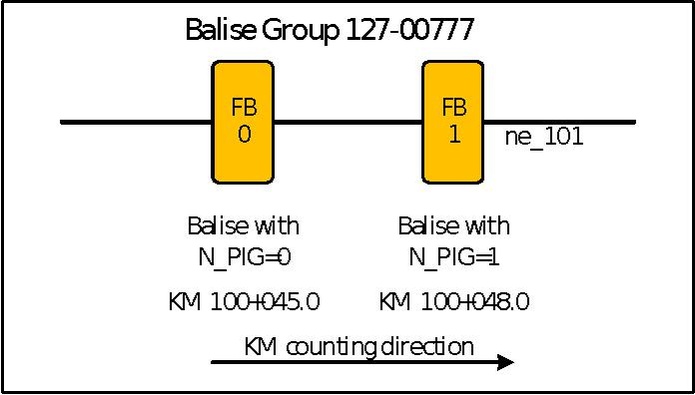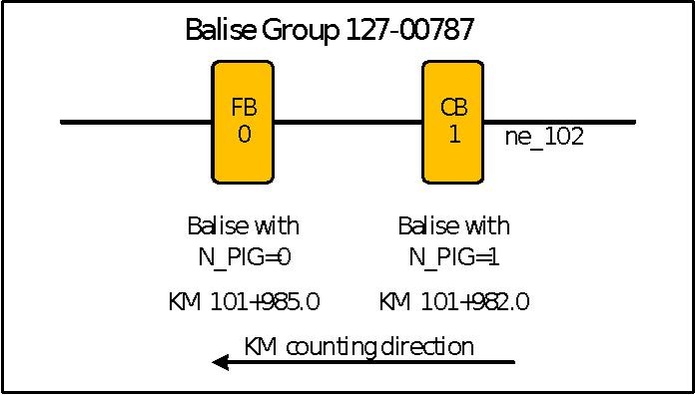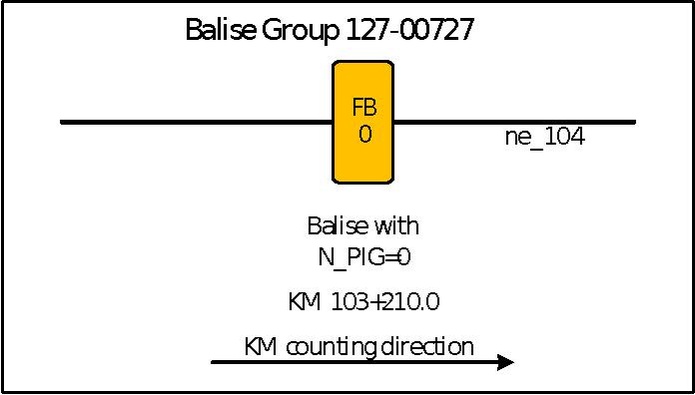User:RailML Coord Documentation/IS:balise
Introduction
Relation between railML® elements <baliseGroup> and <balise>
In balise based ATP systems, each “balise” belongs to a “balise group”.
Consequently, for balise based ATP systems, there are two levels of description: the higher level “balise group”, which is presented by the railML® element “baliseGroup” and the more detailed level “balise”, presented by the railML® element “balise”.
Usually, the definition of balise groups in the track layout is sufficient for the most purposes and it is not necessary additionally to give information about each balise of a balise group, because all relevant information for the ATP software engineering can be derived from the element “baliseGroup”. For example, all variables required for an ETCS balise telegram header according to SUBSET-026 (versions 2.3.0, 3.4.0 or 3.6.0), section 8.4.2.1, can be calculated from the information given by element “baliseGroup”.
Nevertheless, railML® provides the possibility to specify each balise of a balise group, which can make sense in cases where the exact location of each balise in a balise group is important, for example for special test purposes or for the mounting and installation of the balises.
Conclusion:
The use of railML® “balise” elements is optional.
But if railML® “balise” elements are used, then the railML® “baliseGroup” elements are mandatory. Each “balise” element must reference a “baliseGroup” element.
Concept of the railML® element “balise”
Correspondent to the concept of railML® element “baliseGroup”, also the railML® element “balise” is suitable for all balise based ATP systems. This means, a railML® element “balise” can be a KVB balise, an Ebicab balise, a RSDD balise (together known as KER balises) or a Eurobalise.
The general information provided for all hardware types of balises is:
- the location of the balise (using sub-element spotLocation)
- to which balise group the balise belongs to (using attibute belongsToBaliseGroup)
- the distance to the predecessor balise within the group (using attribute distanceToPredecessorBaliseWithinGroup)
In case of Eurobalise, the optional sub-element “isEurobalise“ shall be used to specify the ETCS related information:
- the value of UNISIG variable N_PIG (provided in railML® by attribute positionInGroup), which is defined by UNISIG in SUBSET-026 (versions 2.3.0, 3.4.0 or 3.6.0), section 7.5.1.81
- the value of UNISIG variable M_DUP (provided in railML® by attribute duplicate), which is defined by UNISIG in SUBSET-026 (versions 2.3.0, 3.4.0 or 3.6.0), section 7.5.1.63 and
- the value of UNISIG variable M_VERSION (provided in railML® by attribute mVersion), which is defined by UNISIG in SUBSET-026 (versions 2.3.0, 3.4.0 or 3.6.0), section 7.5.1.79
Best Practice / Examples
Example 1 – Eurobalises belonging to a Eurobalise group consisting of 2 fix data balises
This example shows the balise elements belonging to the ETCS balise group presented in section 1.2.1 of railML® element “baliseGroup”.
Example 1 – Balise group of 2 fix data balises
- Corresponding railML® description
<balises>
<balise id="bg1_bal0" type="fixed" belongsToBaliseGroup="bg1"
distanceToPredecessorBaliseWithinGroup="0.0">
<name name="127-00777-0" description="etcsName" language="EN"/>
<spotLocation id="bg1_bal0_sloc01" netElementRef="ne_101"
applicationDirection="both" pos="45.0">
<linearCoordinate positioningSystemRef="lps01" measure="100045.0"/>
</spotLocation>
<isEurobalise positionInGroup="0" duplicate="no" mVersion="32"/>
</balise>
<balise id="bg1_bal1" type="fixed" belongsToBaliseGroup="bg1"
distanceToPredecessorBaliseWithinGroup="3.0">
<name name="127-00777-1" description="etcsName" language="EN"/>
<spotLocation id="bg1_bal1_sloc01" netElementRef="ne_101"
applicationDirection="both" pos="48.0">
<linearCoordinate positioningSystemRef="lps01" measure="100048.0"/>
</spotLocation>
<isEurobalise positionInGroup="1" duplicate="no" mVersion="32"/>
</balise>
<balises/>
Example 2 – Eurobalises belonging to a Eurobalise group consisting of 1 fix data balise and 1 controlled balise
This example shows the balise elements belonging to the ETCS balise group presented in section 1.2.2 of railML® element “baliseGroup”.
Example 2 – Balise group of 1 fix data balise and 1 controlled balise
- Corresponding railML® description
<balises>
<balise id="bg1_bal0" type="fixed" belongsToBaliseGroup="bg1"
distanceToPredecessorBaliseWithinGroup="0.0">
<name name="127-00777-0" description="etcsName" language="EN"/>
<spotLocation id="bg1_bal0_sloc01" netElementRef="ne_101"
applicationDirection="both" pos="45.0">
<linearCoordinate positioningSystemRef="lps01" measure="100045.0"/>
</spotLocation>
<isEurobalise positionInGroup="0" duplicate="no" mVersion="32"/>
</balise>
<balise id="bg1_bal1" type="fixed" belongsToBaliseGroup="bg1"
distanceToPredecessorBaliseWithinGroup="3.0">
<name name="127-00777-1" description="etcsName" language="EN"/>
<spotLocation id="bg1_bal1_sloc01" netElementRef="ne_101"
applicationDirection="both" pos="48.0">
<linearCoordinate positioningSystemRef="lps01" measure="100048.0"/>
</spotLocation>
<isEurobalise positionInGroup="1" duplicate="no" mVersion="32"/>
</balise>
<balises/>
Example 3 – A Eurobalise belonging to an Eurobalise group consisting of 1 fix data balise
This example shows the balise elements belonging to the ETCS balise group presented in section 1.2.4 of railML® element “baliseGroup”.
Example 3 – Balise group of 1 fix data balise
- Corresponding railML® description
<balises>
<balise id="bg4_bal0" type="fixed" belongsToBaliseGroup="bg4"
distanceToPredecessorBaliseWithinGroup="0.0">
<name name="127-00727-0" description="etcsName" language="EN"/>
<spotLocation id="bg4_bal0_sloc01" netElementRef="ne_104"
applicationDirection="both" pos="210.0">
<linearCoordinate positioningSystemRef="lps01" measure="103210.0"/>
</spotLocation>
<isEurobalise positionInGroup="0" duplicate="no" mVersion="16"/>
</balise>
<balises/>
Additional Information
Open Issues
If the general information provided by the railML® element “balise” is not sufficient for a KER balise application, then please open a request in the railML® forum – Template:Sita – reporting the missing information to be modelled in railML®. railML®.org will provide a suggestion for modelling the missing information in railML®, for example added by a new optional sub-element “railML/infrastructure/functionalInfrastructure/balises/
balise/isEbicabBalise“ which includes the new requested information.


